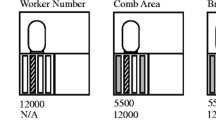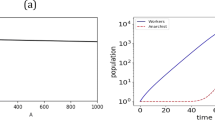Abstract
Honey bee colonies furnish their nests with two types of comb distinguished by cell size: large cells for rearing males (drone comb) and small cells for rearing workers (worker comb). The bees actively regulate the relative quantity of each type, a behavior likely to be important in setting a colony's sex ratio. Experimental analysis of the information pathways and control mechanisms responsible for this regulation found the following results. The amount of drone comb in a nest is governed by negative feedback from drone comb already constructed. This feedback depends on the workers having direct contact with the drone comb in their nest, but does not depend on the queen's contact with the comb. The comb itself, rather than the brood within it, is sufficient to provide the negative feedback, although the brood may also contribute to the effect. These findings show that drone comb regulation does not depend on the queen acting as a centralized information gatherer and behavioral controller. Instead, the evidence points to a decision-making process distributed across the population of worker bees, a control architecture typical of colony organization in honey bees and other large-colony insect societies.
Similar content being viewed by others
Author information
Authors and Affiliations
Additional information
Received: 24 May 1997 / Accepted after revision: 30 August 1997
Rights and permissions
About this article
Cite this article
Pratt, S. Decentralized control of drone comb construction in honey bee colonies. Behav Ecol Sociobiol 42, 193–205 (1998). https://doi.org/10.1007/s002650050431
Issue Date:
DOI: https://doi.org/10.1007/s002650050431




